Box #5: Family & Community
Artifact Pictures & Descriptions
Four Wooden Hippopotamus Families
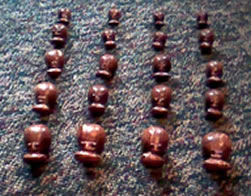 Made from teak wood and hand carved by Senegalese artists. These depict the typical Senegalese family; they are lined up in a column, from largest to smallest, with size being equal to importance. The father is first in line, the largest member of the family, making the money and the important decisions. The mother follows behind her husband and is much smaller in size. Then follow the three children. One set of hippos is actually a reduced version of a Senegalese family, as there are typically many more children and, in some families, many mothers. For this reason, four families were purchased, to also allow for children to use equal size models for her or his parents and to represent divorced or extended family structures. I set up one family and we discussed the role of each member in a typical Senegalese family. The students took turns creating their own families with the hippos, naming each member. We emphasized that family roles are not the same for each family (some dads stay home, some brothers do all the laundry).
Made from teak wood and hand carved by Senegalese artists. These depict the typical Senegalese family; they are lined up in a column, from largest to smallest, with size being equal to importance. The father is first in line, the largest member of the family, making the money and the important decisions. The mother follows behind her husband and is much smaller in size. Then follow the three children. One set of hippos is actually a reduced version of a Senegalese family, as there are typically many more children and, in some families, many mothers. For this reason, four families were purchased, to also allow for children to use equal size models for her or his parents and to represent divorced or extended family structures. I set up one family and we discussed the role of each member in a typical Senegalese family. The students took turns creating their own families with the hippos, naming each member. We emphasized that family roles are not the same for each family (some dads stay home, some brothers do all the laundry).
Four postcards of people doing work
 Purchased in Senegal as a part of a unit about families and the activities each family member does. One shows a man drumming. Musicians are a typical career for teenage and adult men in Senegal . Another postcard shows a woman selling fruit in the market. Women-owned businesses are a recent addition to the Senegalese economy. Many places in the country have programs to help women learn to read and do math in order to run their business successfully. Another postcard shows men herding cattle. As a traditional source of income, herding is a major cause of family migration and conflict between cultures. Today, herding is still popular but the family usually stays at home while the father leaves for months at a time. The last postcard depicts a fraction of the work women do. They are gathering grains for the family to eat. The women wear the cloth around their heads, partly for fashion, and partly to serve as a cushion so they may carry heavy items for long distances.
Purchased in Senegal as a part of a unit about families and the activities each family member does. One shows a man drumming. Musicians are a typical career for teenage and adult men in Senegal . Another postcard shows a woman selling fruit in the market. Women-owned businesses are a recent addition to the Senegalese economy. Many places in the country have programs to help women learn to read and do math in order to run their business successfully. Another postcard shows men herding cattle. As a traditional source of income, herding is a major cause of family migration and conflict between cultures. Today, herding is still popular but the family usually stays at home while the father leaves for months at a time. The last postcard depicts a fraction of the work women do. They are gathering grains for the family to eat. The women wear the cloth around their heads, partly for fashion, and partly to serve as a cushion so they may carry heavy items for long distances.
Map of Africa
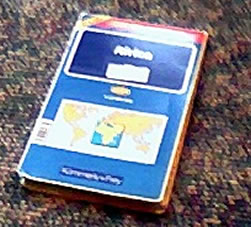
This map was purchased in Paris because I could not find a map of anything anywhere in Senegal . The map has been used in lessons to show children exactly where Senegal is in the continent of Africa and so children may identify other countries they know or have heard about. It would be interesting to compare this to the older maps still hanging in many American classrooms. The constitution of the continent has and is changing so rapidly that there is a history lesson in the comparison of any two maps of Africa . Especially consider the story told when viewing a map of Africa before World War II, when the majority of the land was under colonial control.
Map of the World
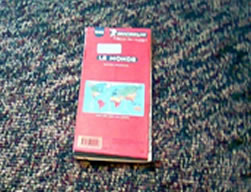 This map of the world shows the relationship of Senegal to every other country. Its westernmost location on the continent of Africa made it the ideal departure point for the enslaved to be transplanted to European countries. While this map is designed to be excellent for navigation purposes, it greatly distorts the actual area of countries. To get a better idea of size comparisons, find a Peters Projection Map. For example, all of the United States can fit into the top half of Africa .
This map of the world shows the relationship of Senegal to every other country. Its westernmost location on the continent of Africa made it the ideal departure point for the enslaved to be transplanted to European countries. While this map is designed to be excellent for navigation purposes, it greatly distorts the actual area of countries. To get a better idea of size comparisons, find a Peters Projection Map. For example, all of the United States can fit into the top half of Africa .
Chinese loose tea for making Senegalese tea
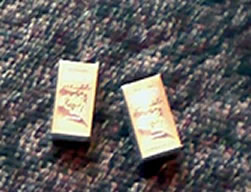 Tea drinking is a very important part of building community in Senegal . The ritual can take several hours at each sitting, making the participants communicate and get to know one another. At least three pots of tea are made. The first round is very strong and sweet. The second round is slightly less strong and much sweeter. The third round is weak but very very sweet, as more sugar cubes are added each round, but the amount of tea leaves remain the same. One person in each house is typically known as the expert tea maker. Tea is made in a silver pot, over the open flame of a propane tank. Stoves or ovens are very rare and propane tanks are the most common way all cooking is done. Serving tea is considered the custom when receiving guests in one's home. Also, the tea is not considered good unless it has a think layer of foam on the top of the cup. An expert tea maker knows that this layer of foam is created by pouring the tea into the cup by holding the kettle high in the air. Then the tea is poured back and forth between two cups several times to enhance the foam. The higher one holds the pouring cup, the more foam created.
Tea drinking is a very important part of building community in Senegal . The ritual can take several hours at each sitting, making the participants communicate and get to know one another. At least three pots of tea are made. The first round is very strong and sweet. The second round is slightly less strong and much sweeter. The third round is weak but very very sweet, as more sugar cubes are added each round, but the amount of tea leaves remain the same. One person in each house is typically known as the expert tea maker. Tea is made in a silver pot, over the open flame of a propane tank. Stoves or ovens are very rare and propane tanks are the most common way all cooking is done. Serving tea is considered the custom when receiving guests in one's home. Also, the tea is not considered good unless it has a think layer of foam on the top of the cup. An expert tea maker knows that this layer of foam is created by pouring the tea into the cup by holding the kettle high in the air. Then the tea is poured back and forth between two cups several times to enhance the foam. The higher one holds the pouring cup, the more foam created.
Two children's books
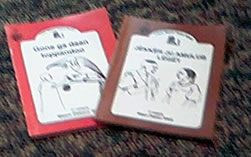 Mame Daour Wade [mah-m dah-oor wah-d] is the author of these books. He is a well-known storyteller throughout Senegal and belongs to the Association of Storytellers (Contes au Clair de Lune). Wade began collecting folk stories because he wanted to preserve that part of Senegalese tradition. Books are rare in most families for several reasons, but primarily because books written in native languages are very expensive for new learners that are mostly rural people and because books are a relatively recent arrival to Senegal. Wade’s books are prized because their contents are drawn from the rich African stories and written in Wolof, a native language of Senegal. For every one of Wade’s books purchased, he will be able to lower the price for villagers in the countryside. They are useful to American children because the story can still be told (or invented) through the pictures, though an English translation is included. Additional copies or other books written by Wade can be obtained through contacting Stephanie Evergreen at stephanie.evergreen@wmich.edu.
Mame Daour Wade [mah-m dah-oor wah-d] is the author of these books. He is a well-known storyteller throughout Senegal and belongs to the Association of Storytellers (Contes au Clair de Lune). Wade began collecting folk stories because he wanted to preserve that part of Senegalese tradition. Books are rare in most families for several reasons, but primarily because books written in native languages are very expensive for new learners that are mostly rural people and because books are a relatively recent arrival to Senegal. Wade’s books are prized because their contents are drawn from the rich African stories and written in Wolof, a native language of Senegal. For every one of Wade’s books purchased, he will be able to lower the price for villagers in the countryside. They are useful to American children because the story can still be told (or invented) through the pictures, though an English translation is included. Additional copies or other books written by Wade can be obtained through contacting Stephanie Evergreen at stephanie.evergreen@wmich.edu.
Handwashing bowl with kettle
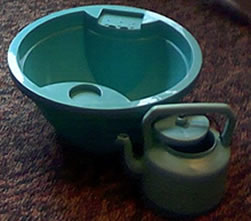 Most Senegalese households do not have running water. Bathrooms typically consist of a hole in the ground, sometimes in an enclosed area outdoors, sometimes behind a piece of rusted metal in the backyard. Families use these bowls and kettles to wash their hands. The kettle is filled with water. Soap sits in the bumpy area on the bowl. One person must hold the kettle and pour the water over the hands of the person needing a washing. In this manner, one cannot even wash her or his own hands without the help of others in the community. The pourer must be mindful and careful to not pour too much and to pour the water where it is most needed. The dirty water is then disposed of in the grass outside. This activity can stand alone or be used after eating a meal around the common bowl.
Most Senegalese households do not have running water. Bathrooms typically consist of a hole in the ground, sometimes in an enclosed area outdoors, sometimes behind a piece of rusted metal in the backyard. Families use these bowls and kettles to wash their hands. The kettle is filled with water. Soap sits in the bumpy area on the bowl. One person must hold the kettle and pour the water over the hands of the person needing a washing. In this manner, one cannot even wash her or his own hands without the help of others in the community. The pourer must be mindful and careful to not pour too much and to pour the water where it is most needed. The dirty water is then disposed of in the grass outside. This activity can stand alone or be used after eating a meal around the common bowl.
Six glass cups for tea
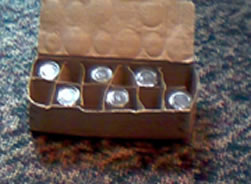 These are Senegalese tea cups. To make the tea, fill as many tea cups with water as people who will be drinking the tea (so, four people, fill four tea cups with water). Pour the water into the kettle. Light the fire and place the kettle on the fire. Empty ¾ a bag of tea leaves into the water. Boiling should take about ten minutes. The water will want to boil over, so, at that point, move the kettle half on the flame, half off, to maintain a steady boil. Add one to two tablespoons of sugar to the boiling water. Many people choose to add fresh mint leaves at this point. Check the tea by pouring one cup. The color should be very dark, like coffee. Then pour the cups of tea by holding the kettle high in the air to create the much-desired foam. Build the foam by pouring tea back and forth between two cups. In the next round of tea, add three tablespoons of sugar but do not add anymore tea leaves. In the last round of tea, add four or more tablespoons of sugar. Don't worry if there are not enough cups for everyone. Most families in Senegal understand that taking turns and sharing is important. They typically can't afford as many cups as they would like, so the elders get tea first, then another pot is made while they are sipping their tea and, by the time the cups are empty, the second pot is ready to go.
These are Senegalese tea cups. To make the tea, fill as many tea cups with water as people who will be drinking the tea (so, four people, fill four tea cups with water). Pour the water into the kettle. Light the fire and place the kettle on the fire. Empty ¾ a bag of tea leaves into the water. Boiling should take about ten minutes. The water will want to boil over, so, at that point, move the kettle half on the flame, half off, to maintain a steady boil. Add one to two tablespoons of sugar to the boiling water. Many people choose to add fresh mint leaves at this point. Check the tea by pouring one cup. The color should be very dark, like coffee. Then pour the cups of tea by holding the kettle high in the air to create the much-desired foam. Build the foam by pouring tea back and forth between two cups. In the next round of tea, add three tablespoons of sugar but do not add anymore tea leaves. In the last round of tea, add four or more tablespoons of sugar. Don't worry if there are not enough cups for everyone. Most families in Senegal understand that taking turns and sharing is important. They typically can't afford as many cups as they would like, so the elders get tea first, then another pot is made while they are sipping their tea and, by the time the cups are empty, the second pot is ready to go.
Goree Island postcard
 Goree Island sits off the very westernmost point of Senegal. It is visible on the map of Africa . Because of its isolation, the island served as the holding point for enslaved people just before departing to a European country. The island still has the original slave house. There are separate rooms for men and women, young people, and children. Rooms were 7' by 6 ½'. The young girls' room of this size might fit fifteen to twenty people. In this room, so cramped they had to constantly be standing, they would eat, sleep, use the bathroom and suffer for three months before leaving on a ship, never to see home again. The island is also home to two museums. One is about the history of the slave trade, the other about the women in African history. Today the island has people living on it, complete with a market to sell goods and a mayor. For more information, see the book on the history of the slave house and the photographs included in this artifact collection.
Goree Island sits off the very westernmost point of Senegal. It is visible on the map of Africa . Because of its isolation, the island served as the holding point for enslaved people just before departing to a European country. The island still has the original slave house. There are separate rooms for men and women, young people, and children. Rooms were 7' by 6 ½'. The young girls' room of this size might fit fifteen to twenty people. In this room, so cramped they had to constantly be standing, they would eat, sleep, use the bathroom and suffer for three months before leaving on a ship, never to see home again. The island is also home to two museums. One is about the history of the slave trade, the other about the women in African history. Today the island has people living on it, complete with a market to sell goods and a mayor. For more information, see the book on the history of the slave house and the photographs included in this artifact collection.
Mosque postcards
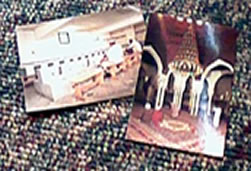 Islam is the religion of Senegal . Islamic people worship in a mosque. Prayer occurs five times each day, though followers do not always have to make it to the mosque each time to pray. They kneel on mats to pray, and as long as one has a mat, praying can take place anywhere. These two postcards are from the Grand Mosque in Paris . The French were the ones who colonized Senegal and the two cultures have exchanged many traditions. In one postcard, the men are washing before prayer. This process is called "ablution" and must be done before one enters the prayer hall. Ablutions must take place even if one is praying outside the mosque. The second picture is inside the prayer hall. Non-Muslims may not enter the prayer hall. The rug in the center serves as one large prayer mat for everyone. Notice that both postcards show only men. Women are rarely visible in the mosque. Usually they have too many household duties to attend to, but even if they come, their section of the prayer hall is one corner, sometimes caged in, where the men cannot see them. Some mosques do not allow women until after menopause. The degree of liberation varies from mosque to mosque.
Islam is the religion of Senegal . Islamic people worship in a mosque. Prayer occurs five times each day, though followers do not always have to make it to the mosque each time to pray. They kneel on mats to pray, and as long as one has a mat, praying can take place anywhere. These two postcards are from the Grand Mosque in Paris . The French were the ones who colonized Senegal and the two cultures have exchanged many traditions. In one postcard, the men are washing before prayer. This process is called "ablution" and must be done before one enters the prayer hall. Ablutions must take place even if one is praying outside the mosque. The second picture is inside the prayer hall. Non-Muslims may not enter the prayer hall. The rug in the center serves as one large prayer mat for everyone. Notice that both postcards show only men. Women are rarely visible in the mosque. Usually they have too many household duties to attend to, but even if they come, their section of the prayer hall is one corner, sometimes caged in, where the men cannot see them. Some mosques do not allow women until after menopause. The degree of liberation varies from mosque to mosque.
Book on history of slave house on Goree Island
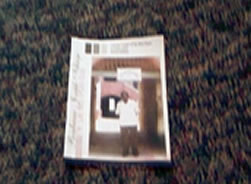 The man pictured on the cover of the book is the keeper and tour guide of the slave house on Goree Island . He is also the author of the book. The book provides a healthy background of information on the activities that took place in the slave house when it was in use. This artifact is excellent in collaboration with the postcard of Goree Island and the photographs also in this artifact collection.
The man pictured on the cover of the book is the keeper and tour guide of the slave house on Goree Island . He is also the author of the book. The book provides a healthy background of information on the activities that took place in the slave house when it was in use. This artifact is excellent in collaboration with the postcard of Goree Island and the photographs also in this artifact collection.
Eating mat
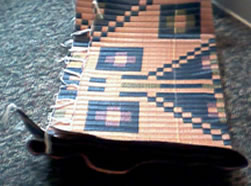 Senegalese meals are eaten on the floor, as tables are expensive to a family that has no income. Eating mats are relatively cheap and are laid out on the floor. The meal is placed on the mat. This way, any food that is spilled during the course of the meal and easily be collected and put in the garbage. As a sign of respect, shoes must be removed before stepping on the mat. Large families either purchase several mats or eat meals in shifts, first the elders (especially the men), receiving the best pieces of meat and vegetables. Then the children would eat when the elders have finished. Finally the women eat whatever is left over, rarely having anything but the rice in the bottom of the dish. Then the women clear the dishes and roll up the mat to collect the waste and clean up. See the recipe for Cebu Djen for an authentic Senegalese meal. No one speaks during a meal. Adults model this for the children, with the reasoning that children may choke on a piece of rice if trying to speak and eat at the same time. All communication must be non-verbal. This is a great community-builder, as you try to gracefully eat orange food with your hands. Tea usually follows the meal.
Senegalese meals are eaten on the floor, as tables are expensive to a family that has no income. Eating mats are relatively cheap and are laid out on the floor. The meal is placed on the mat. This way, any food that is spilled during the course of the meal and easily be collected and put in the garbage. As a sign of respect, shoes must be removed before stepping on the mat. Large families either purchase several mats or eat meals in shifts, first the elders (especially the men), receiving the best pieces of meat and vegetables. Then the children would eat when the elders have finished. Finally the women eat whatever is left over, rarely having anything but the rice in the bottom of the dish. Then the women clear the dishes and roll up the mat to collect the waste and clean up. See the recipe for Cebu Djen for an authentic Senegalese meal. No one speaks during a meal. Adults model this for the children, with the reasoning that children may choke on a piece of rice if trying to speak and eat at the same time. All communication must be non-verbal. This is a great community-builder, as you try to gracefully eat orange food with your hands. Tea usually follows the meal.
Eating bowl
 Meals are served from one common bowl. The bowl is placed on the eating mat and everyone sits around it, on the floor. Shoes must be removed. Rice makes up the bottom layer of the dish and meat and vegetables are placed in the center of the bowl. Imagine the bowl as a pizza. One eats only from the slice directly in front of him or her. Reaching across to someone else's place is considered very rude. Eating takes place with hands instead of silverware, and, to be correct, only the right hand. The left hand is typically considered dirty because it is used in the bathroom. Westerners might find it easier to actually sit on the left hand to refrain from using it. Napkins are spread across the lap. The oldest person around the bowl breaks up and divides the meat and vegetables to each person. The youngest person stabilizes the bowl. Scoop a small handful of rice and vegetable and gently squeeze it into a ball in the right hand. Then put the ball in the mouth. Finish chewing and swallow before getting another handful, as not to be seen as greedy. When finished eating, clean up your spot, including straightening the rice in your piece of the bowl. Then get up and use the handwashing kettle to rinse your hands and face.
Meals are served from one common bowl. The bowl is placed on the eating mat and everyone sits around it, on the floor. Shoes must be removed. Rice makes up the bottom layer of the dish and meat and vegetables are placed in the center of the bowl. Imagine the bowl as a pizza. One eats only from the slice directly in front of him or her. Reaching across to someone else's place is considered very rude. Eating takes place with hands instead of silverware, and, to be correct, only the right hand. The left hand is typically considered dirty because it is used in the bathroom. Westerners might find it easier to actually sit on the left hand to refrain from using it. Napkins are spread across the lap. The oldest person around the bowl breaks up and divides the meat and vegetables to each person. The youngest person stabilizes the bowl. Scoop a small handful of rice and vegetable and gently squeeze it into a ball in the right hand. Then put the ball in the mouth. Finish chewing and swallow before getting another handful, as not to be seen as greedy. When finished eating, clean up your spot, including straightening the rice in your piece of the bowl. Then get up and use the handwashing kettle to rinse your hands and face.
Recipe for Cebu Djen
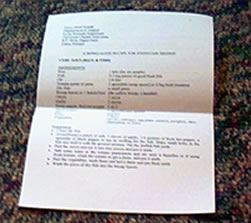 This dish is extremely common and popular in Senegal because it is so easy to make. All five ingredients grow right in the country. (Think about creating a dish with five ingredients that grow in your backyard.) Senegal has the coastline of the ocean and several rivers, so fishing is a major activity and source of nutrition for this dish. "Ceb" means fish , "u" means and , and "djen" means vegetables , and is pronounced (cheb oo jen). Ceb is a hearty fish found in Senegalese waters. It is also what the girls call a nice-looking guy, referring to his healthiness. It is not uncommon to have this same dish for many meals in a row. This is because the mother must go to the market directly before cooking to purchase the ingredients for each meal (no refrigerators). So it is easier and more convenient to purchase a lot of the same thing and eat leftovers (though they are not refrigerated).
This dish is extremely common and popular in Senegal because it is so easy to make. All five ingredients grow right in the country. (Think about creating a dish with five ingredients that grow in your backyard.) Senegal has the coastline of the ocean and several rivers, so fishing is a major activity and source of nutrition for this dish. "Ceb" means fish , "u" means and , and "djen" means vegetables , and is pronounced (cheb oo jen). Ceb is a hearty fish found in Senegalese waters. It is also what the girls call a nice-looking guy, referring to his healthiness. It is not uncommon to have this same dish for many meals in a row. This is because the mother must go to the market directly before cooking to purchase the ingredients for each meal (no refrigerators). So it is easier and more convenient to purchase a lot of the same thing and eat leftovers (though they are not refrigerated).
Senegalese Family Tree
 The author of the family tree is Fatou D., located in the lower center of the tree. She has six brothers and sisters between her biological mother and father. Her father was polygamous and had one other daughter. Gender is designated. Fatou married Mamadou Kandji and this is shown through a diagonal line connecting their two names and going to the right. They have a monogamous relationship, with four children. Mamadou was married previously, as shown, and had three children in that marriage. To the left of Fatou is her parent's generation. Her maternal grandparents were polygamous, but, as is common in these kinds of families, she does not know all of the members of that family. Only part of the siblings have been named. This family is extremely large and this is between mostly monogamous relationships. The children in polygamous families that we met typically did not know or see the majority of their very extended family. It would be interesting to compare this with modern American family trees, reflecting the divorce and remarriage trend.
The author of the family tree is Fatou D., located in the lower center of the tree. She has six brothers and sisters between her biological mother and father. Her father was polygamous and had one other daughter. Gender is designated. Fatou married Mamadou Kandji and this is shown through a diagonal line connecting their two names and going to the right. They have a monogamous relationship, with four children. Mamadou was married previously, as shown, and had three children in that marriage. To the left of Fatou is her parent's generation. Her maternal grandparents were polygamous, but, as is common in these kinds of families, she does not know all of the members of that family. Only part of the siblings have been named. This family is extremely large and this is between mostly monogamous relationships. The children in polygamous families that we met typically did not know or see the majority of their very extended family. It would be interesting to compare this with modern American family trees, reflecting the divorce and remarriage trend.
Yegoo Magazine
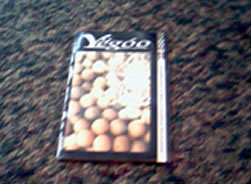 African Consultants International puts out this periodical. It is useful because it is printed in English and gives a good idea of the culture in Senegal . Especially of noting are the music reviews, which seem to reflect a culture much like that of ours in the West. Page 3 has an article titled "Lekkal!" This phrase is commonly heard at Senegalese dinners. It means "Eat more!" Like many grandmothers, it is hard to turn down seconds in a Senegalese household. This article also offers an alternative recipe for Cebu Djen (spelled ceeb u jen here) and several other popular Senegalese dishes. The articles are mostly written as contributions from Americans who have lived in Senegal for sometime and want to help other Westerners grasp the culture in the country. Page 13 has pictures of children in school. Though limited, it gives an idea to the conditions children will bear in order to receive an education.
African Consultants International puts out this periodical. It is useful because it is printed in English and gives a good idea of the culture in Senegal . Especially of noting are the music reviews, which seem to reflect a culture much like that of ours in the West. Page 3 has an article titled "Lekkal!" This phrase is commonly heard at Senegalese dinners. It means "Eat more!" Like many grandmothers, it is hard to turn down seconds in a Senegalese household. This article also offers an alternative recipe for Cebu Djen (spelled ceeb u jen here) and several other popular Senegalese dishes. The articles are mostly written as contributions from Americans who have lived in Senegal for sometime and want to help other Westerners grasp the culture in the country. Page 13 has pictures of children in school. Though limited, it gives an idea to the conditions children will bear in order to receive an education.
Photographs
 The thirty photographs were all taken between June and July 2003 in Senegal, Africa. The photographs show the tour of the slave house on Goree Island, the work of men, women, and children, the complete process of dying a tablecloth, and the schools and environment of Senegal. They are accompanied by a written description of each picture to clarify and give historical context. Copies can be made available through the contact listed on the "Inventory List".
The thirty photographs were all taken between June and July 2003 in Senegal, Africa. The photographs show the tour of the slave house on Goree Island, the work of men, women, and children, the complete process of dying a tablecloth, and the schools and environment of Senegal. They are accompanied by a written description of each picture to clarify and give historical context. Copies can be made available through the contact listed on the "Inventory List".